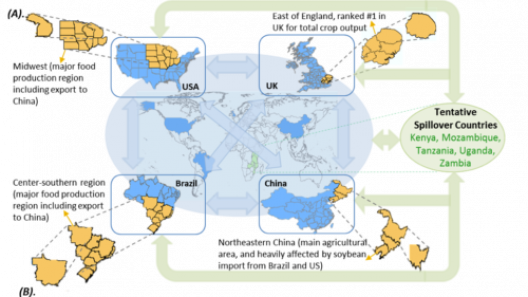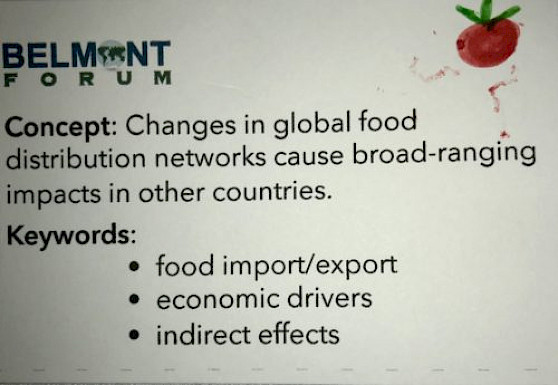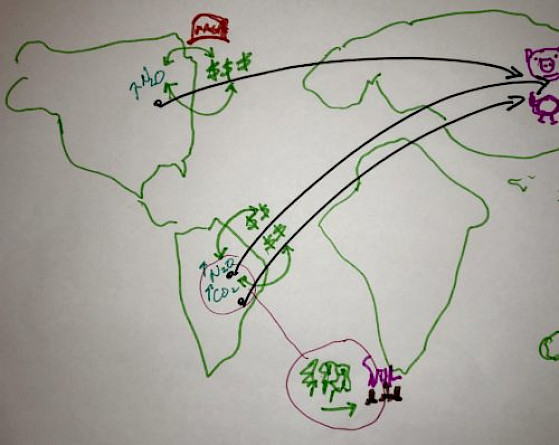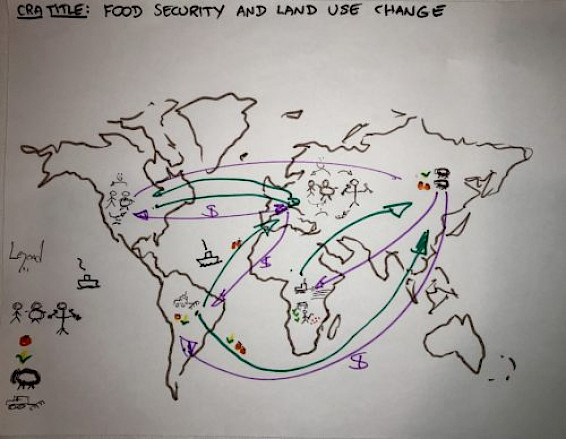Finding the value of Transdisciplinary Research on Food Security and Land Use Change
Heath Kelsey ·

IAN has been working with the Belmont Forum since December,
2016 to help communicate the added value of transdisciplinary and transnational
research approaches as a pathway to sustainability. Our first
workshop with this group was in San Francisco, in conjunction with
the 2016 American
Geophysical Union (AGU) Conference, where we produced a synthesis of
key findings from two Collaborative Research Actions (CRAs): Coastal
Vulnerability and Freshwater
Security. We’ve been continuing to work with Belmont on the
Biodiversity CRA, and most recently the Food
Security, Mountains
as Sentinels of Change, and Arctic
Observing and Research for Sustainability CRAs in advance of the 2018
AGU Conference in Washington DC.
Sky Swanson and I
helped facilitate discussions among the Food Security CRA representatives. Food
Security CRA projects represented at the meeting included Delivering Food
Security on Limited Land (DEVIL),
Food Security Impacts of Industrial Expansion in Sub-Saharan Africa (FICESSA),
and Food Security and Land Use Change: The Telecoupling Challenge (ABC
Telecoupling). Representatives from one additional project titled
African Food, Agriculture, Land and Natural Resource Dynamics in the context of
Global Agro-Food-Energy System Changes (AFGROLAND)
were not able to attend.
We first received a summary of each project, which prompted great discussions among the participants. Being a relatively small group representing only three projects, we had a bit of extra time to dig deeper into some of the details and implications of each project.

The food security discussion was fascinating: Global food trade and distribution networks are driven by the major economic markets (USA, China, Europe), but changes in flows within these networks (think tariffs, or drought) have profound impacts on the food supply and economy of other countries that may be outside of the primary network. These countries have been termed “overflow” countries. For example, changes in the flow of soybeans from Brazil and the US to China can have important effects on the economy and food security in several African countries. These projects used models to investigate relationships between countries and their effects on food security in overflow countries, and to develop scenarios for improvements in food production and sustainability.
To summarize each project, each group created an “And, But, Therefore”
statement at the workshop that describes their project. These summaries provide
a very succinct overview of the project that touches on the need for the
project, the approach, and the expected outcomes:
ABC Telecoupling
Everyone recognizes globalization is increasing trade of
agricultural commodities. There are positive effects on food security but also
potential unintended consequences on land use. Therefore, we are simulating
future dynamics under a range of scenarios to inform stakeholders about
possible actions to be taken.
DEVIL
The green revolution dramatically increased crop yields over
the past half century. However, production trends are not on track to meet the
food and nutrition security needs of 9 to 10 billion people by 2050. New
solutions are needed to sustainably feed a growing population on a warming
planet. This project aims to identify multiple pathways for creating a
sustainable and nutritious food system, both globally and regionally.
FICESSA
Industrial crops such as sugarcane, oil palm, and cocoa have underpinned the economies of many African countries. They have been major engines of economic growth through foreign exchange earnings and rural development. However, their expansion can have important implications for food security at the local and the national level.

Following the overviews of each project, we started discussing the common themes around the shared goals and values of transdisciplinary and transnational research. We use the SNAP activity (explained here) to elicit responses from the entire group, and then organize them into common themes. In the values discussion, participants viewed global collaboration, interdisciplinarity, and engagement with stakeholders and new colleagues as the top values from the Belmont Forum approach. Challenges voiced related to the varied expectations and procedures from the different participating countries, difficulty translating results into practical outcomes, and the ability to follow up with projects after the project period.


On Day 2, we brought the three groups together to complete the synthesis, and co-create the content for the workshop newsletter. One activity (a crowd favorite) is a game called “Conceptionary,” in which participants draw selected environmental concepts and other team members guess the concept and associated key words. After everyone gets “in the drawing mood,” we have each group work together to create one diagram that synthesizes all of the projects in the CRA.

This meeting was really enjoyable, as all of our Belmont Forum meetings have been, because of the wonderful people working to address difficult issues and improve the sustainability of our world. People often ask me how I feel about the fate of the planet, given the negative stories that abound. My response usually has something to do with all the positive work I see people doing wherever I go. I get to travel to some amazing places in this job, and I always come back with another story about what great passion people have for improving things. I’m encouraged that, in every place I’ve ever been, there are groups of people working hard to make our world more sustainable. I’m lucky that I get to see that, and that I get to share their stories. This meeting was another reminder that, even though things may seem bleak sometimes, there are a lot of people pushing in the right direction.
About the author
Heath Kelsey

Heath Kelsey has been with IAN since 2009, as a Science Integrator, Program Manager, and as Director since 2019. His work focuses on helping communities become more engaged in socio-environmental decision making. He has over 15-years of experience in stakeholder engagement, environmental and public health assessment, indicator development, and science communication. He has led numerous ecosystem health and socio-environmental health report card projects globally, in Australia, India, the South Pacific, Africa, and throughout the US. Dr. Kelsey received his MSPH (2000) and PhD (2006) from The University of South Carolina Arnold School of Public Health. He is a graduate of St Mary’s College of Maryland (1988), and was a Peace Corps Volunteer in Papua New Guinea from 1995-1998.

